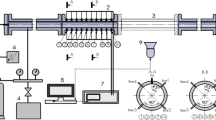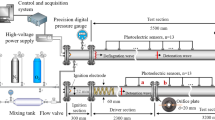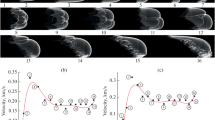Abstract
Detonation propagation, re-initiation, and flame propagation in acetylene–air mixtures were investigated in a channel with a transverse dimension that is comparable with the width of the detonation cell. Experiments were carried out in a channel with a square cross-section of 5 mm \(\times \) 5 mm. The detonation wave passed from the driver section into the transparent test section. The trajectories of the propagation of glowing combustion products (high-speed image sequences) were recorded, and high-speed schlieren image sequences of the reaction zone and shock waves were obtained. The flame front velocity was measured. The intensity of the shock waves was measured with piezoelectric pressure transducers. Depending on the equivalence ratio ER, four modes of combustion propagation were detected: (1) steady detonation; (2) decay and re-initiation of detonation; (3) detonation decay and flame acceleration; and (4) detonation decay and the absence of flame acceleration. Quantitative evaluation of the boundary layer thickness was carried out. The intensity of the shock wave and the flame front velocity were analysed for different modes. It was shown that the re-initiation of detonation in a mixture of acetylene and air with \(\text {ER} = 1.6\) is characterized by a spatial interval of \(1000\pm 50\) mm and a time interval of \(1300\pm 100~\upmu \hbox {s}\).







Similar content being viewed by others
Abbreviations
- D :
-
Hydraulic diameter of the channel
- d :
-
Internal diameter of the orifice
- \(\mathrm{ER}\) :
-
Equivalence ratio, the molar excess of fuel
- H :
-
Width of the square cross-section channel
- h :
-
The smallest side of the rectangular channel
- M :
-
Mach number of the shock wave
- N :
-
Number of processed tests
- \(T_0\) :
-
Initial temperature (293 K)
- \(T_1\) :
-
Temperature behind the shock wave front
- \(\triangle t\) :
-
Time interval between the passage of the shock wave and the flame front
- V :
-
Flame front velocity
- \(V_\mathrm{m}\) :
-
Maximum flame front velocity after the detonation decay
- \(V_{\mathrm{CJ}}\) :
-
Velocity of Chapman–Jouguet detonation
- w :
-
Shock wave velocity
- \(w_\mathrm{D}\) :
-
Detonation velocity
- x :
-
Distance along the channel
- z :
-
Distance behind the shock wave
- \(\alpha \) :
-
Molar fraction of fuel
- \(\gamma \) :
-
Heat capacity ratio
- \(\delta \) :
-
Boundary layer thickness
- \(\eta \) :
-
Viscosity at the post-shock state
- \(\lambda \) :
-
Detonation cell size
- \(\nu \), \(\xi \) :
-
Auxiliary parameters for calculation of the velocity deficit
- \(\rho _0\) :
-
Initial density
- CW :
-
Compression waves
- DW :
-
Detonation wave
- FF :
-
Flame front
- LSW :
-
Leading shock wave
- PMT :
-
Photomultiplier tube
- SSW :
-
Secondary shock wave
References
Mirels, H.: Shock tube test time limitation due to turbulent wall boundary layer. AIAA J. 2(1), 84–93 (1964). https://doi.org/10.2514/3.2218
Mirels, H.: Attenuation in a shock tube due to unsteady-boundary-layer action. National Advisory Committee for Aeronautics, Report 1333 (1957). https://ntrs.nasa.gov/api/citations/19930092322/downloads/19930092322.pdf
Golub, V.V., Gurentsov, E.V., Emel’yanov, A.V., Eremin, A.V., Fortov, V.E.: Energy gain of the detonation pyrolysis of acetylene. High Temp. 53(3), 363–369 (2015). https://doi.org/10.1134/S0018151X15030062
Gao, Y., Ng, H.D., Lee, J.H.: Experimental characterization of galloping detonations in unstable mixtures. Combust. Flame 162(6), 2405–2413 (2015). https://doi.org/10.1016/j.combustflame.2015.02.007
Vasil’ev, A.A.: Quasi-steady regimes of wave propagation in active mixtures. Shock Waves 18(4), 245–253 (2008). https://doi.org/10.1007/s00193-008-0168-4
Manzhalei, V.I.: Low-velocity detonation limits of gaseous mixtures. Combust. Explos. Shock Waves 35(3), 296–302 (1999). https://doi.org/10.1007/BF02674453
Zhang, B., Wang, C., Shen, X., Yan, L., Yan, B., Xia, Y.: Velocity fluctuation analysis near detonation propagation limits for stoichiometric methane–hydrogen–oxygen mixture. Int. J. Hydrogen Energy 41(39), 17750–17759 (2016). https://doi.org/10.1016/j.ijhydene.2016.08.017
Tsuboi, N., Morii, Y., Hayashi, A.K.: Two-dimensional numerical simulation on galloping detonation in a narrow channel. Proc. Combust. Inst. 34(2), 1999–2007 (2013). https://doi.org/10.1016/j.proci.2012.06.132
Jackson, S., Lee, B.J., Shepherd, J.: E: Detonation mode and frequency analysis under high loss conditions for stoichiometric propane-oxygen. Combust. Flame 167, 24–38 (2016). https://doi.org/10.1016/j.combustflame.2016.02.030
Lee, J.J., Dupré, G., Knystautas, R., Lee, J.H.: Doppler interferometry study of unstable detonations. Shock Waves 5(3), 175–181 (1995). https://doi.org/10.1007/BF01435525
Edwards, D.H., Morgan, J.M.: Instabilities in detonation waves near the limits of propagation. J. Phys. D Appl. Phys. 10(17), 2377–2387 (1977). https://doi.org/10.1088/0022-3727/10/17/009/pdf
Cao, W., Gao, D., Ng, H.D., Lee, J.H.S.: Experimental investigation of near-limit gaseous detonations in small diameter spiral tubing. Proc. Combust. Inst. 37(3), 3555–3563 (2019). https://doi.org/10.1016/j.proci.2018.08.027
Manzhalei, V.I.: Detonation regimes of gases in capillaries. Combust. Explos. Shock Waves 28(3), 296–302 (1992). https://doi.org/10.1007/BF00749647
Ul’yanitskii, V.Y.: Galloping mode in a gas detonation. Combust. Explos. Shock Waves 17(1), 93–97 (1981). https://doi.org/10.1007/BF00772793
Ishii, K., Gronig, H.: Behavior of detonation waves at low pressures. Shock Waves 8(1), 55–61 (1998). https://doi.org/10.1007/s001930050098
Wu, M.H., Kuo, W.C.: Transmission of near-limit detonation wave through a planar sudden expansion in a narrow channel. Combust. Flame 159(11), 3414–3422 (2012). https://doi.org/10.1016/j.combustflame.2012.06.006
Kagan, L., Sivashinsky, G.: On the transition from deflagration to detonation in narrow tubes. Flow Turbul. Combust. 84(3), 423–437 (2010). https://doi.org/10.1007/s10494-010-9252-9
Kagan, L.: On the transition from deflagration to detonation in narrow channels. Math. Model. Nat. Phenomena 2(2), 40–55 (2007). https://doi.org/10.1051/mmnp:2008018
Li, J., Zhang, P., Yuan, L., Pan, Z., Zhu, Y.: Flame propagation and detonation initiation distance of ethylene/oxygen in narrow gap. Appl. Therm. Eng. 110, 1274–1282 (2017). https://doi.org/10.1016/j.applthermaleng.2016.09.037
Wu, M.H., Burke, M.P., Son, S.F., Yetter, R.A.: Flame acceleration and the transition to detonation of stoichiometric ethylene/oxygen in microscale tubes. Proc. Combust. Inst. 31(2), 2429–2436 (2007). https://doi.org/10.1016/j.proci.2006.08.098
Chan, H.P., Wu, M.H.: Stages of flame acceleration and detonation transition in a thin channel filled with stoichiometric ethylene/oxygen mixture. 26th International Colloquium on the Dynamics of Explosions and Reactive Systems, Boston, MA, Paper 1017 (2017)
Nagai, K., Okabe, T., Kim, K., Yoshihashi, T., Obara, T., Ohyagi, S.: A study on DDT processes in a narrow channel. Proceedings of the XXVI International Symposium on Shock Waves, vol. 1, pp. 203–208. Springer, Heidelberg (2009). https://doi.org/10.1007/978-3-540-85168-4_31
Oran, E.S., Gamezo, V.N.: Flame acceleration and detonation transition in narrow tubes. 20th International Colloquium on the Dynamics of Explosions and Reactive Systems, Montreal, Paper 240 (2005)
Ott, J.D., Oran, E.S., Anderson Jr., J.D.: A mechanism for flame acceleration in narrow tubes. AIAA J. 41(7), 1391–1396 (2003). https://doi.org/10.2514/2.2088
Gao, Y., Ng, H.D., Lee, J.H.S.: Minimum tube diameters for steady propagation of gaseous detonations. Shock Waves 24(4), 447–454 (2014). https://doi.org/10.1007/s00193-014-0505-8
Peraldi, O., Knystautas, R., Lee, J.H.: Criteria for transition to detonation in tubes. Symp. (Int.) Combust. 21(1), 1629–1637 (1988). https://doi.org/10.1016/S0082-0784(88)80396-5
Ciccarelli, G., Wang, Z., Lu, J., Cross, M.: Effect of orifice plate spacing on detonation propagation. J. Loss Prev. Process Ind. 49, 739–744 (2017). https://doi.org/10.1016/j.jlp.2017.03.014
Pan, Z., Chen, K., Pan, J., Zhang, P., Zhu, Y., Qi, J.: An experimental study of the propagation characteristics for a detonation wave of ethylene/oxygen in narrow gaps. Exp. Therm. Fluid Sci. 88, 354–360 (2017). https://doi.org/10.1016/j.expthermflusci.2017.06.015
Pan, Z., Qi, J., Pan, J., Zhang, P., Zhu, Y., Gui, M.: Fabrication of a helical detonation channel: effect of initial pressure on the detonation propagation modes of ethylene/oxygen mixtures. Combust. Flame 192, 1–9 (2018). https://doi.org/10.1016/j.combustflame.2018.01.041
Dupré, G., Joannon, J., Knystautas, R., Lee, J.: Unstable detonations in the near-limit regime in tubes. Symp. (Int.) Combust. 23(1), 1813–1820 (1991). https://doi.org/10.1016/S0082-0784(06)80461-3
Vasil’ev, L.A.: Shadow Methods. Nauka, Moscow (1968). (in Russian)
Golovastov, S.V., Bivol, G.Y., Alexandrova, D.: Evolution of detonation wave and parameters of its attenuation when passing along a porous coating. Exp. Therm. Fluid Sci. 100, 124–134 (2019). https://doi.org/10.1016/j.expthermflusci.2018.08.030
Williams, A., Smith, D.B.: Combustion and oxidation of acetylene. Chem. Rev. 70(2), 267–293 (1970). https://doi.org/10.1021/cr60264a004
Vasil’ev, A.A.: Dynamic parameters of detonation. In: Zhang, F. (ed.) Shock Waves Science and Technology Library, vol. 6, pp. 213–279. Springer, Heidelberg (2012). https://doi.org/10.1007/978-3-642-22967-1_4
Knystautas, R.: Measurement of cell size in hydrocarbon–air mixtures and predictions of critical tube diameter, critical initiation energy and detonability limits. Prog. Astronaut. Aeronaut. 94, 23–37 (1984). https://doi.org/10.2514/5.9781600865695.0023.0037
Tieszen, S.R., Stamps, D.W., Westbrook, C.K., Pitz, W.J.: Gaseous hydrocarbon–air detonations. Combust. Flame 84(3–4), 376–390 (1991). https://doi.org/10.1016/0010-2180(91)90013-2
Vasil’ev, A.A.: Cell size as the main geometric parameter of a multifront detonation wave. J. Propul. Power 22(6), 1245–1260 (2006). https://doi.org/10.2514/1.20348
Bull, D.C., Elsworth, J.E., Shuff, P.J., Metcalfe, E.: Detonation cell structures in fuel/air mixtures. Combust. Flame 45, 7–22 (1982). https://doi.org/10.1016/0010-2180(82)90028-1
Weynants, R. R.: An Experimental investigation of shock–wave diffraction over compression and expansion corners. Report No. UTIAS-TN-126, Toronto University (Ontario) Institute for Aerospace Studies (1968)
Zhang, B., Shen, X., Pang, L., Gao, Y.: Detonation velocity deficits of H\(_2\)/O\(_2\)/Ar mixture in round tube and annular channels. Int. J. Hydrogen Energy 40(43), 15078–15087 (2015). https://doi.org/10.1016/j.ijhydene.2015.09.036
Ishii, K., Monwar, M.: Detonation propagation with velocity deficits in narrow channels. Proc. Combust. Inst. 33(2), 2359–2366 (2011). https://doi.org/10.1016/j.proci.2010.07.051
Camargo, A., Ng, H.D., Chao, J., Lee, J.H.S.: Propagation of near-limit gaseous detonations in small diameter tubes. Shock Waves 20(6), 499–508 (2010). https://doi.org/10.1007/s00193-010-0253-3
Gooderum, P.B.: An experimental study of the turbulent boundary layer on a shock-tube wall. Report No. 4243, Langley Aeronautical Laboratory, Langley Field, VA, USA (1958) https://ntrs.nasa.gov/archive/nasa/casi.ntrs.nasa.gov/19930085207.pdf
Fay, J.A.: Two-dimensional gaseous detonations: velocity deficit. Phys. Fluids 2(3), 283–289 (1959). https://doi.org/10.1063/1.1705924
Acknowledgements
The work was supported by the Program of Fundamental Support of Academic Institutes, Russia, No. AAAA-A19-119020890034-5.
Author information
Authors and Affiliations
Corresponding author
Additional information
Communicated by G. Ciccarelli.
Publisher's Note
Springer Nature remains neutral with regard to jurisdictional claims in published maps and institutional affiliations.
Rights and permissions
About this article
Cite this article
Golovastov, S.V., Bivol, G.Y. & Golub, V.V. An experimental study of detonation propagation and re-initiation for acetylene–air mixtures in a narrow channel. Shock Waves 31, 49–61 (2021). https://doi.org/10.1007/s00193-020-00985-6
Received:
Revised:
Accepted:
Published:
Issue Date:
DOI: https://doi.org/10.1007/s00193-020-00985-6




